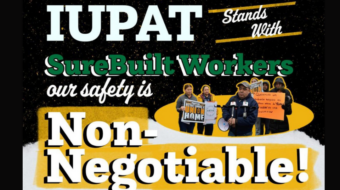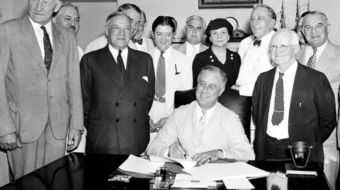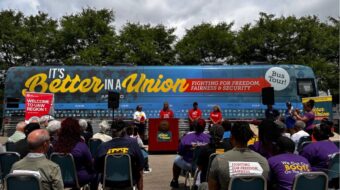For the past year there has been a widening split within the ranks of American organized labor, and this split risks hardening as the new Change to Win (CTW) coalition increasingly takes on the complexion of a rival labor federation.
Thus far, the argument has focused on union organizing efforts and how unions should be structured. Yet, in many ways the split is without purpose because the AFL-CIO is already on the same page as the CTW coalition regarding these issues. This should surprise no one, since CTW leaders were powerful members of the AFL-CIO’s Executive Council for the past decade, where they profoundly influenced federation policy.
In many regards the split is simply the result of frustration at an inability to reverse union decline. The tragedy is that the real issue remains out of focus on both sides (I’ll make no friends here). That issue is the significance of economic policy and politics in union strategy. It is an issue that does not warrant a split, but it does warrant prime time and could even provide the frame for a galvanizing debate that jump-starts the entire union movement and changes national politics. This crucial debate can be framed as “sliced bread” versus “the box.”
The sliced-bread strategic approach comes out of the Service Employees International Union, a major force within the CTW. Late last year, SEIU launched a “greatest idea since sliced bread” competition that asked ordinary Americans what they thought were the most critically needed policy initiatives. The goal was to launch an unprecedented national conversation about how to strengthen the economy and improve life for working men and women.
The sliced-bread competition was jazzy and attention grabbing, reflecting the imaginative and innovative characteristics that distinguish SEIU. But sliced bread was much more than a one-time competition. It also was a statement about where unions should be headed. From the sliced-bread perspective, unions must find those economic initiatives that people want, are important, and are doable. The challenge is to work within the existing system, and find a new place for unions.
Such a view leads to talk of “partnering with our employers” and of unions taking over and organizing outsourcing. It posits that when it comes to globalization, there is no going back and unions must adapt innovatively to the new environment — the core parameters of the economic system are given, and unions have to live and work within those parameters. Only later, after unions have rebuilt themselves, can these parameters be re-visited and changed.
This framework contrasts with the box, a concept that has gradually emerged at the AFL-CIO and whose political implications are still being digested. The box depicts workers as boxed in on all sides by the new economic order. Imagine a square whose sides are labeled globalization (west), less-than-full employment (north), privatization and small government (east), and labor market flexibility (south). Private sector workers are pressured by globalization, which allows corporations to put them in international competition with oppressed low-wage workers. Public sector workers are pressured by privatization, which places them in competition with private sector workers.
Both groups are pressed from north and south by less-than-full employment and labor market flexibility. Less-than-full employment is where the Federal Reserve enters, since it puts a floor to unemployment in the name of price stability. Labor market flexibility strips workers of employment protections and unemployment insurance, degrades the minimum wage and makes union organizing nearly impossible.
A box perspective leads to radically different conclusions than the sliced-bread view. The current system has unions running just to stay in place. As quickly as they organize new workers, companies ship existing union jobs offshore. Manufacturing was first to feel this, but in the future many parts of the service sector also will. From a box perspective, the problem is systemic and the challenge is to change the system — not to adapt to it.
Right now, corporations have workers boxed in. The challenge is to reverse the situation and put CEOs and corporations in the box, as did the institutional innovations of the New Deal. That task is easier said than done. Not only must the economics of corporate globalization be discredited, but new affirmative arguments for an alternative must also be put forward. Unions also must provide a compelling alternative to free-market rhetoric and ideology, a task that has barely begun.
The CTW sliced bread and AFL-CIO box perspectives imply radically different road maps. The former grudgingly accepts today’s economic structure. Consequently, the policies that determine the structure of the economy and the economic ideas that drive these policies are not the key issue. Instead, organizing is, and the belief is that organizing can be successful regardless of structure. Moreover, since ideas and policy are not on the critical path, unions can even reduce engagement with Washington and party politics.
In stark contrast, the AFL-CIO box demands immediate system change, and that in turn requires new economic arguments that can change policy and politics. Organizing cannot succeed without this change because it is the structure of economic arrangements that is tearing the heart out of unions. Changing the economic policies that shape the economic structure is therefore squarely on the critical path. At the political level, it forces a profound intellectual break with the current Democratic Party elite because Rubinomics (the economics of the Clinton administration) is the box. This political strategy is dramatically different from reduced political engagement.
Where next? First, as of the moment the split looks to be festering. This is a tragedy. A head-to-head debate on these issues is needed, not a split within organized labor. Second, for the AFL-CIO the challenge is to break with the Democratic Party elite without splitting the party, as that could hand victory to Republicans whose version of the box is even more extreme. In effect, the AFL-CIO is dealing with an economic box within a political box.
Thomas Palley, a widely published economist, served as the AFL-CIO’s assistant director of public policy. This article is reprinted from The Guild Reporter (www.newsguild.org) a publication of The Newspaper Guild/CWA.









